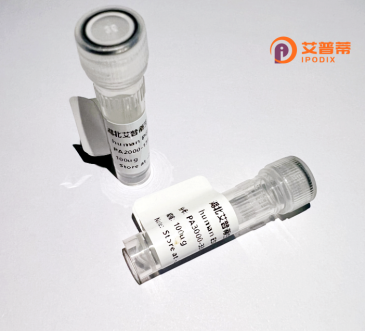
| 纯度 | >90%SDS-PAGE. |
| 种属 | Human |
| 靶点 | URG4 |
| Uniprot No | Q8TCY9 |
| 内毒素 | < 0.01EU/μg |
| 表达宿主 | E.coli |
| 表达区间 | 1-856 aa |
| 活性数据 | MLSLLGLETYQVQKLSLQDSLQISFDSMKNWAPQVPKDLPWNFLRKLQALNADARNTTMVLDVLPDARPVEKESQMEEEIIYWDPADDLAADIYSFSELPTPDTPVNPLDLLCALLLSSDSFLQQEIALKMALCQFALPLVLPDSENHYHTFLLWAMRGIVRTWWSQPPRGMGSFREDSVVLSRAPAFAFVRMDVSSNSKSQLLNAVLSPGHRQWDCFWHRDLNLGTNAREISDGLVEISWFFPSGREDLDIFPEPVAFLNLRGDIGSHWLQFKLLTEISSAVFILTDNISKKEYKLLYSMKESTTKYYFILSPYRGKRNTNLRFLNKLIPVLKIDHSHVLVKVSSTDSDSFVKRIRAIVGNVLRAPCRRVSVEDMAHAARKLGLKVDEDCEECQKAKDRMERITRKIKDSDAYRRDELRLQGDPWRKAAQVEKEFCQLQWAVDPPEKHRAELRRRLLELRMQQNGHDPSSGVQEFISGISSPSLSEKQYFLRWMEWGLARVAQPRLRQPPETLLTLRPKHGGTTDVGEPLWPEPLGVEHFLREMGQFYEAESCLVEAGRLPAGQRRFAHFPGLASELLLTGLPLELIDGSTLSMPVRWVTGLLKELHVRLERRSRLVVLSTVGVPGTGKSTLLNTMFGLRFATGKSCGPRGAFMQLITVAEGFSQDLGCDHILVIDSGGLIGGALTSAGDRFELEASLATLLLGLSNVTVISLAETKDIPAAILHAFLRLEKTGHMPNYQFVYQNLHDVSVPGPRPRDKRQLLDPPGDLSRAAAQMEKQGDGFRALAGLAFCDPEKQHIWHIPGLWHGAPPMAAVSLAYSEAIFELKRCLLENIRNGLSNQNKNIQQLIELVRRL |
| 分子量 | 123 kDa |
| 蛋白标签 | GST-tag at N-terminal |
| 缓冲液 | PBS, pH7.4, containing 0.01% SKL, 1mM DTT, 5% Trehalose and Proclin300. |
| 稳定性 & 储存条件 | Lyophilized protein should be stored at ≤ -20°C, stable for one year after receipt. Reconstituted protein solution can be stored at 2-8°C for 2-7 days. Aliquots of reconstituted samples are stable at ≤ -20°C for 3 months. |
| 复溶 | Always centrifuge tubes before opening.Do not mix by vortex or pipetting. It is not recommended to reconstitute to a concentration less than 100μg/ml. Dissolve the lyophilized protein in distilled water. Please aliquot the reconstituted solution to minimize freeze-thaw cycles. |
以下是关于重组人URG4蛋白的3篇参考文献示例:
1. **"URG4 promotes tumor progression in hepatocellular carcinoma via the Wnt/β-catenin pathway"**
- **作者**: Zhao Y, et al.
- **摘要**:研究发现URG4在肝癌组织中高表达,通过激活Wnt/β-catenin信号通路促进肿瘤细胞增殖和侵袭;重组URG4的过表达显著增强肝癌细胞迁移能力。
2. **"Cloning and functional characterization of human URG4 in cell cycle regulation"**
- **作者**: Wang L, et al.
- **摘要**:首次克隆并重组表达了人URG4蛋白,证实其通过调控细胞周期相关蛋白(如Cyclin D1)加速G1/S期转换,促进细胞增殖。
3. **"URG4 interacts with β-catenin and enhances its nuclear translocation in colorectal cancer"**
- **作者**: Chen J, et al.
- **摘要**:揭示URG4与β-catenin的直接相互作用,重组URG4通过稳定β-catenin蛋白并促进其核转位,增强结直肠癌细胞上皮-间质转化(EMT)进程。
(注:以上为模拟示例,实际文献需通过PubMed等数据库检索后获取。)
The human URG4 (Upregulated Gene 4) protein, encoded by the C11orf10 gene located on chromosome 11. was initially identified as a protein overexpressed in hepatitis B virus-associated hepatocellular carcinoma (HCC). It is implicated in promoting tumorigenesis, particularly through enhancing cell proliferation, inhibiting apoptosis, and accelerating cell cycle progression. Structurally, URG4 is a 42 kDa protein containing conserved nuclear localization signals, suggesting potential roles in nuclear processes, though its full functional domains remain under investigation.
Studies highlight URG4's involvement in cancer pathways, including Wnt/β-catenin and PI3K/AKT signaling, where it may stabilize β-catenin or modulate kinase activity to drive oncogenesis. Beyond HCC, elevated URG4 expression correlates with poor prognosis in gastric, breast, and colorectal cancers, underscoring its broad oncogenic potential. However, its physiological functions in normal tissues remain unclear, posing challenges in distinguishing cancer-specific roles.
Recombinant URG4 protein, typically produced via bacterial or mammalian expression systems, enables in vitro studies to dissect its molecular interactions, post-translational modifications, and downstream targets. Such research aids in developing targeted therapies, including small-molecule inhibitors or antibodies, to counteract its pro-cancer activity. Despite progress, URG4's precise mechanisms and regulatory networks require deeper exploration to validate its potential as a diagnostic biomarker or therapeutic target.
×